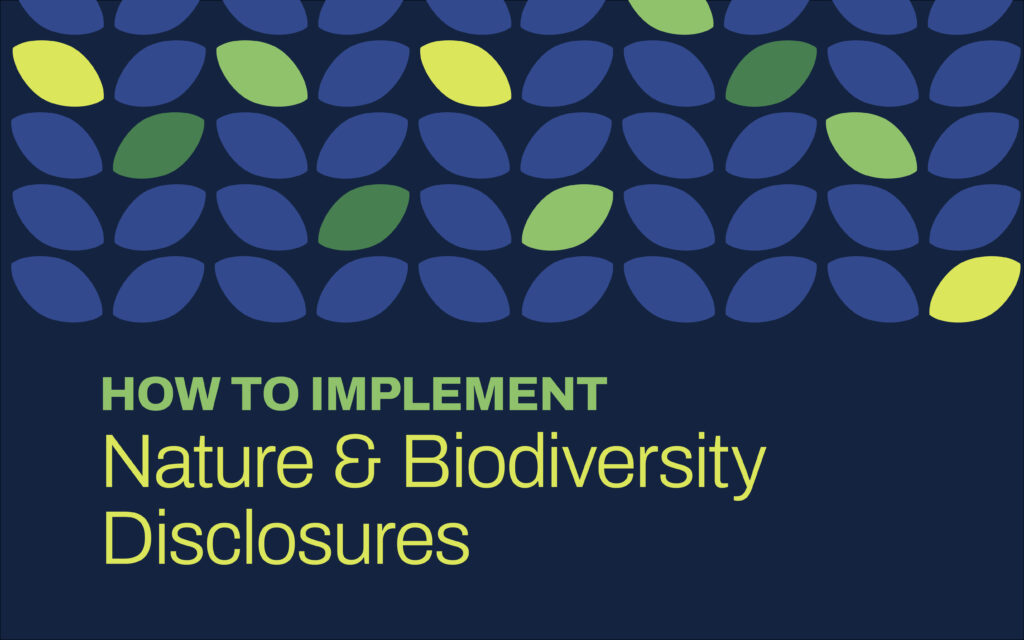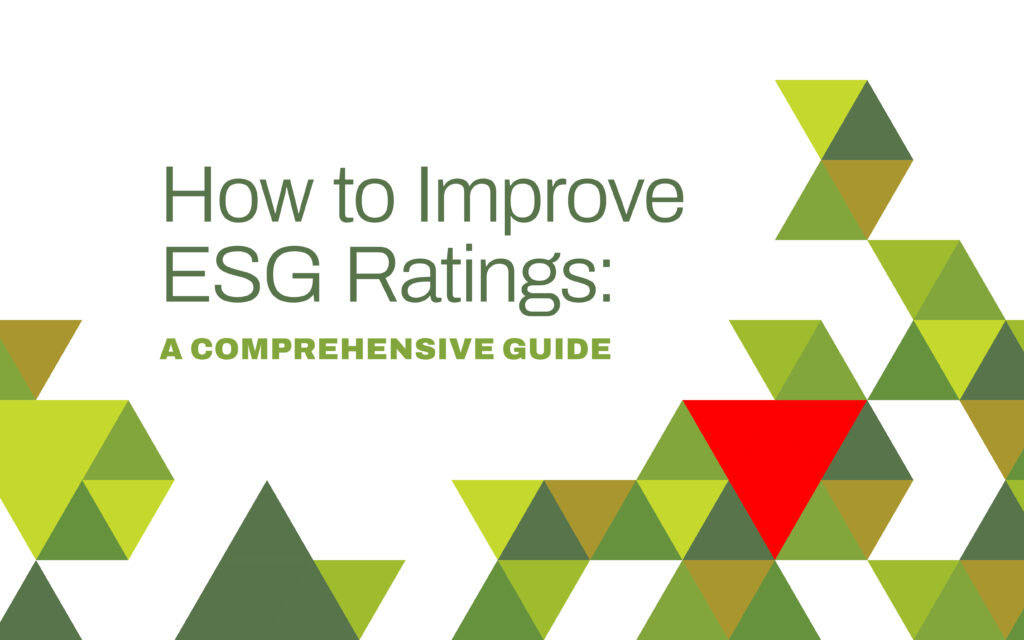How to Implement Nature & Biodiversity Disclosures
Sustainability & ESG / July 3, 2024
By Mary Riddle

Nature and biodiversity are increasingly recognized as critical factors in corporate risk management and investment decisions. The loss of biodiversity has far-reaching impacts on global economies and the financial sector.
Investors, regulators and stakeholders increasingly expect companies to disclose their impacts on nature and biodiversity. This expectation is driving the emergence of frameworks like the Taskforce on Nature-related Financial Disclosures (TNFD).
TNFD provides a standardized approach to reporting on nature-related financial risks and opportunities. It also highlights the interconnection between climate change and biodiversity, and their collective influence on ESG disclosures.
Companies looking to report on their nature and biodiversity disclosures should follow these ten steps:
Step 1: Recognize the Importance of Biodiversity to Your Business
Biodiversity is not just an environmental issue. It’s a business issue.
Biodiversity loss can disrupt supply chains, increase operational costs, and pose reputational risks. On the other hand, a healthy biodiversity can support business operations by providing ecosystem services like pollination, water purification, and climate regulation.
Recognizing the importance of biodiversity to your business is the first step towards effective nature and biodiversity disclosures. It sets the stage for understanding your company’s impacts and dependencies on nature, and for integrating biodiversity considerations into your corporate strategy and decision-making.
Step 2: Align with the Taskforce on Nature-related Financial Disclosures
TNFD is emerging as a key framework for nature and biodiversity disclosures. It aims to provide a standardized approach to reporting on nature-related risks and opportunities, similar to the Taskforce on Climate-related Financial Disclosures (TCFD).
Aligning with the TNFD can help your company meet investor and stakeholder expectations for transparency and accountability. It can also guide your company in identifying, assessing, and managing nature-related financial risks and opportunities.
Key aspects of the TNFD framework include:
- Understanding the organization’s impacts and dependencies on nature
- Assessing nature-related risks and opportunities
- Integrating nature-related issues into governance and strategy
- Disclosing nature-related financial impacts
By aligning with the TNFD, your company can enhance the credibility of its nature and biodiversity disclosures and contribute to a more sustainable and resilient financial system.
Step 3: Conduct a Materiality Assessment for Biodiversity
A materiality assessment is a crucial step to take before implementing nature and biodiversity disclosures. This process helps identify the biodiversity issues that are most relevant to your business and stakeholders.
The assessment should consider both the direct and indirect impacts of your business activities on biodiversity. It should also take into account your business’s dependencies on ecosystem services. This comprehensive approach can help your company understand its full biodiversity footprint.
The results of the materiality assessment can guide your company in setting priorities and targets for biodiversity management and can also inform your biodiversity disclosure strategy, ensuring that your reporting is focused and relevant.
Step 4: Develop Standardized Sustainability Metrics
Developing standardized sustainability metrics is a key step in implementing nature and biodiversity disclosures, because these metrics provide a common language for communicating your company’s biodiversity performance.
Standardized metrics can enhance the comparability and consistency of your biodiversity disclosures, facilitating benchmarking and performance tracking over time. This can help your company identify areas for improvement and measure the effectiveness of its biodiversity management strategies.
However, developing these metrics can be challenging due to the complexity and variability of biodiversity. Aligning your metrics with international standards like TNFD can help ensure that your metrics are robust, relevant, and recognized by stakeholders.
Step 5: Integrate Biodiversity into Corporate Transparency Efforts
Companies should incorporate biodiversity considerations into its overall ESG strategy, aligning your biodiversity goals with your company’s broader sustainability objectives. It can also involve integrating biodiversity data into your company’s financial reporting processes.
By doing so, your company can provide a holistic view of its sustainability performance. This can help stakeholders understand the interconnections between your company’s financial performance and its impacts on biodiversity.
Integrating biodiversity and nature disclosures into overall sustainability reporting efforts can contribute to greater stakeholder trust and engagement in your company’s biodiversity management efforts.
Step 6: Engage Stakeholders and Build Partnerships
Communicating with stakeholders about your company’s biodiversity impacts and efforts helps to build trust and foster collaboration in addressing biodiversity challenges.
Your company can engage stakeholders through various means, including public consultations, stakeholder meetings, surveys, and online platforms. Additionally, companies should consider partnering with NGOs, environmental organizations, and other businesses to improve their biodiversity management. These partnerships can provide your company with technical expertise, resources, and networks to enhance its biodiversity efforts.
Engaging stakeholders and building partnerships can not only strengthen your company’s nature and biodiversity disclosures, it can also enhance your company’s reputation and relationships with key stakeholders.
Step 7: Implement Effective Data Collection and Analysis
Effective data collection and analysis are crucial for credible nature and biodiversity disclosures. Companies cannot understand their biodiversity footprint or develop effective mitigation strategies without collecting accurate and reliable data on its biodiversity impacts and dependencies.
Data collection can be challenging due to the complexity of biodiversity. However, by partnering with organizations specializing in digital tools such as GIS and remote sensing, companies can enhance data collection and analysis and can access detailed and up-to-date information on biodiversity conditions and trends. Partnering with companies specializing in remote sensing can help your company to track its progress towards its biodiversity targets and to report on its performance.
Step 8: Report on Biodiversity Efforts Transparently
Transparency is a key principle of effective nature and biodiversity disclosures. Your company’s biodiversity disclosures should be clear and understandable and should provide a comprehensive picture of your company’s biodiversity performance. This includes both your company’s negative impacts on biodiversity and its positive contributions to biodiversity conservation.
Your company should also be transparent about the methodologies used for biodiversity impact assessments. This can help stakeholders to understand how your company measures its biodiversity impacts and to assess the credibility of its disclosures. Biodiversity disclosures and methodologies should be in your company’s annual sustainability report or integrated report.
Step 9: Ensure Continuous Improvement and Adaptation
Biodiversity is a dynamic field, with new scientific findings and policy developments emerging regularly. Your company should stay up-to-date with emerging trends in order to refine biodiversity strategies and disclosures accordingly. This can help your company ensure continuous improvement and enhance the effectiveness of its disclosures.
Step 10: Lead by Example and Influence the Industry
By demonstrating a strong commitment to biodiversity and by implementing effective disclosure practices, your company can inspire other companies to follow suit.
Your company can also actively participate in industry initiatives and collaborations to set common standards for biodiversity reporting. This can help to harmonize biodiversity disclosures across the industry and to enhance their comparability and credibility. Additionally, companies should consider implementing governance practices that support biodiversity goals, such as incentivizing employee progress toward biodiversity KPIs.
How OBATA Can Help
The journey towards effective nature and biodiversity disclosures requires a deep understanding of the importance of nature, a commitment to transparency, and a willingness to continuously improve and adapt.
As the business world increasingly recognizes the value of ecosystem services, the demand for robust and credible biodiversity disclosures will continue to grow.
Companies that lead in this area will not only meet the expectations of investors and stakeholders, but also contribute to the preservation of our planet’s biodiversity.
Is your company seeking assistance with implementing nature and biodiversity disclosures?
Please feel free to contact us for support.


